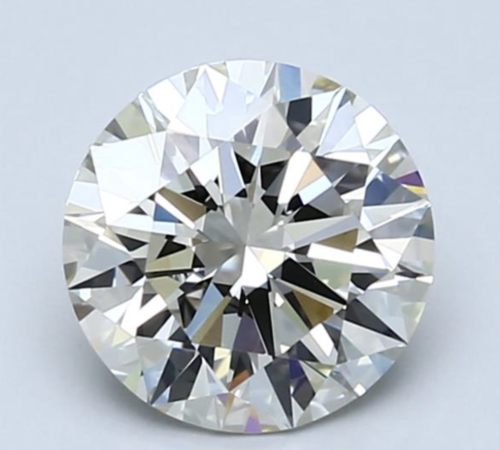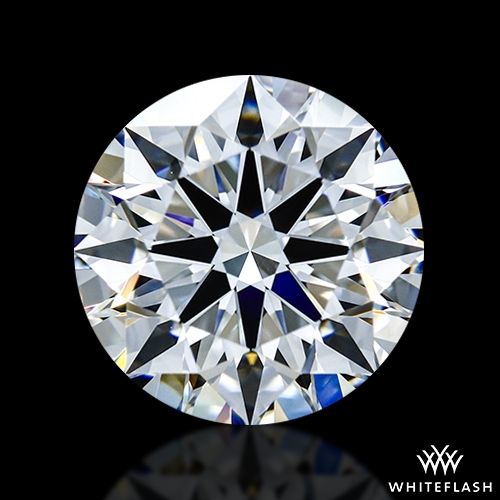This page contains references to diamonds or engagement rings from different companies. Sometimes I do receive a commission when you click on links and buy the products.
As the second-highest grade on the diamond color scale, an E color diamond can seem like a savvier alternative to a more expensive D color diamond. Like their close color companion, they are almost completely absent of color; giving them a stunning, icy white appearance.
From what defines E color diamonds and how they differentiate from others in the scale to when they’re worth purchasing and how to harness their true sparkle, we’ve delved into E color diamonds and their beauty below.
What Defines E Color Diamonds?

Image Courtesy Whiteflash
Before diamonds are sold, they are evaluated and graded for quality by a trusted gemological lab, such as American Gem Society Laboratories (AGS) and Gemological Institute of America (GIA). As part of this grading process, diamonds are accompanied by a certificate listing factors relating to their cut quality, clarity, carat weight and color.
All diamonds receive a grade between D and Z that indicates their color. D, the highest grade, is reserved for diamonds that do not show any color, even when viewed under bright lighting and magnification in laboratory conditions.
So, what does E color really mean? Sitting squarely in the middle of the elite “colorless” range (DEF), this particular color grade is more or less indistinguishable from perfectly colorless. While they may not be quite as transparent as D color diamonds, they will appear completely colorless when viewed with the naked eye.
It also means that an E color diamond, when placed upside down next to a diamond master set, has slightly more color than the D color diamond but slightly less color than the F. The slight differences in color can only be seen consistently in comparison, face down, in a strictly controlled environment.
The difference between them is very subtle, with only an expert gemologist with advanced laboratory equipment able to accurately spot the difference.
From a color perspective, there’s no denying E color diamonds look absolutely ravishing. Their colorless appearance means they are particularly impressive when set in white metals like white gold and platinum, which complement the color of a diamond more clearly than, say, yellow or white gold.
However, this doesn’t necessarily mean that choosing an E color diamond is always the best decision for you. Although, something I will say, not everybody needs to be a diamond expert to see the stark difference between this grade and the lower grades. You only have to look at an E color like this one on Whiteflash:
And a lower graded color to see variability:

Making the Most Out of E Color Diamonds
A diamond’s color shouldn’t take the front seat in your diamond purchasing decision. Something I will always pioneer here is that no matter what grade of diamond you desire, there are always ways to truly unlock its full potential. The famous ‘4C’s’ come to mind here.
So, if you do decide on an E color for your diamond, make sure that all other aspects of your diamond’s quality are also high. The clarity should be VS1 or higher, the cut should be no short of exceptional. As mentioned previously, it also depends on your metal preference for the setting. If you’re a fan of yellow or rose gold for your engagement ring, an E color diamond is most likely not worth it.
As each color grade actually represents a very narrow range, an F color at the low end could conceivably be graded a G at another time. E color diamonds will most likely retain their grade and never fall outside the colorless range, especially when graded by any legitimate lab in any future evaluations.
When it comes to if it’s worth it, only you can decide that. If you truly cannot tell the difference between an E color diamond and a J color diamond, that is your prerogative. In my opinion, opt for a diamond with the highest cut quality (that also makes your heart sing), then choose a color grade that ensures it looks colorless in relation to its setting.
If you’re absolutely set on buying a diamond that’s as close to colorless as possible, buying an E color diamond (or even a D color diamond) will definitely get that highly white, transparent diamond that many desire. While there is nothing wrong with buying a lower grade color fancy shape diamond, doing so isn’t a good idea if your goal is to achieve the most premium combination of aesthetics.
E colored diamonds are one of the most popular choices for engagement rings for a reason. However, one thing to always keep in mind is that the diamond market is not purely based on beauty – although it often takes center stage. Rarity also has a role to play, and E color diamonds are pretty remarkable, second only to the illusive D color diamond.
As always, avoid inflated and inaccurate grades by only buying diamonds with AGS or GIA reports.

Richard Jenkins, The Diamond Guru
Get free assistance from the Diamond Guru today. You’ll be glad you did!
- Secure the best quality diamond for your budget.
- Don’t pay over the odds for your diamond ring.
- Have peace of mind that you didn’t get ripped off.
Have a Question? Contact us now…


